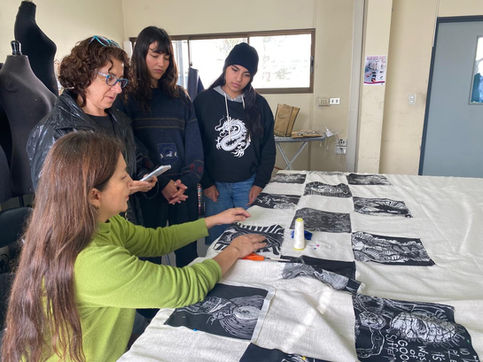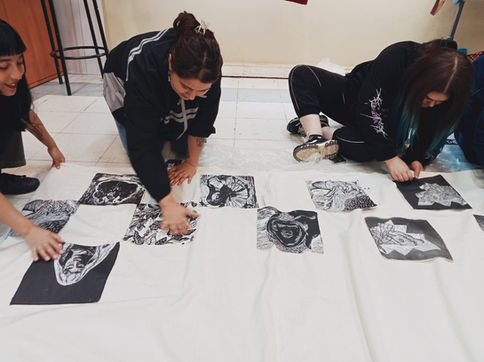MUSA
2024
The work Musa consists of a large raw fabric tunic (6.20 meters in height) representing the Muses, deities of ancient Greece who protected the Arts. According to mythology, the Muses are daughters of Zeus and Mnemosyne, a titan who possessed the ability to preserve memory. Each of their nine daughters had the mission to inspire and safeguard the different arts, poetry, music, theater, dance, and the multitude of forms in which human creation manifests.
The Muses are well-known figures to artists, cited as a source of inspiration and brought to our culture through the transmission of ancient myths from European culture. In America, this cultural heritage has undoubtedly been transformed, re-examined, and re-signified, sometimes denied in an attempt to go back to the roots of indigenous peoples, but always present, admired or hated, impossible to deny.
Our democracies and cities were founded on these conceptual bases of "the ideal"; neoclassical sculptures are still present in our squares and parks, buildings imitating European architecture surround us, and ancestral religiosity has been absorbed by syncretisms evident throughout the continent. This is how this reference to the Muse arises, as an ancestral figure, this time reclaiming her creative feminine power, giver of expression and meaning to human life through artistic expressions.
Valparaíso, a great port of the Pacific, proves to be a key city for the arrival of this European heritage to Chile. Its architectural value, the vibrant creation of poets, musicians, printmakers, photographers, make this reference in the context of the XII Biennial of Art of Valparaíso, aim to generate a moment of veneration towards the figure of the Muse and her significance.

This project involved the participation of two groups of city artists: the advanced printmaking workshop of the School of Art of the Universidad de Playa Ancha who intervened the tunic with their prints, and the performance of the vocal group Sortilegio Vocal Ensemble, as co-protagonist of the action carried out between two buildings in the city plan. This consisted of a procession of the participating artists, carrying the tunic from the "Mercado Puerto" building in the "La Matriz" sector to the "La Nave" building in Sotomayor Square, crossing four streets and briefly interrupting the normal traffic of citizens in this sector of the Port.
The choir performed a work by Cuban composer Leo Brouwer, which is an ode to creation, with roots in local popular music, once again referencing syncretism as a cultural characteristic of our artistic production. The printmaking students explored free themes printed on fabric and later sewn to the hem of the tunic as borders, generating a graphic and monochromatic visual intervention. The sewing of the prints was carried out at the Design School of the University of Valparaíso, in the facilities of their textile workshops.
Participants from the advanced printmaking workshop UPLA:
Darlyn Meneses, Ursula Betancur, Fernanda Michea, Jael González, Sofia Rozas, Carolina Moscoso, Javiera Fuentes, Diego Mora, Cecilia Ojeda, Sofia Arancibia, Kristel Villagrán, Mariel Vergara, Rebeca Chávez, Franko Paredes, Nico Henríquez, Romina Cromilakis, Rocio Vera and Carlos Urrutia.
Teacher: Jorge Martínez.
Audiovisual recording and editing: Freddy Ibarra.







